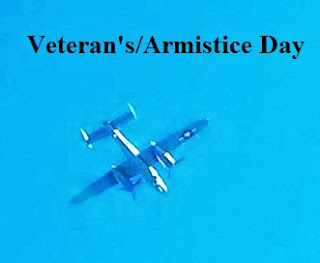The guns in The War to End All Wars
went silent on November 11th, 1918. Even though the French signed
the Treaty
of Versailles on June 28th, 1919 the fighting ended seven months
prior. At this time, much of Europe was in shambles and the war marked a
fundamental shift into a new economy by destroying older state institutions. Europe
was rebuilt away from the traditional monarchical models and into an
international economic framework.
 |
| WWII |
President
Wilson proclaimed the day a holiday in 1919 with the words, “To us in America, the reflections of
Armistice Day will be filled with solemn pride in the heroism of those who died
in the country’s service and with gratitude for the victory, both because of
the thing from which it has freed us and because of the opportunity it has
given America to show her sympathy with peace and justice in the councils of
the nations…”
The
war was seen as resulting from 1.) the assignation of Archduke Francis Ferdinand,
2.) rise of nationalism, 3.) build up of power, 4.) colonial competition, 5.)
alliances that drew in other countries, and 6.) a change of economic landscape.
As these factors rose, there was also pressure to create republics that were
more economically open than the feudal system. WWI helped to change the overall
economic underpinnings of Europe into what it is seen today.
WWII was even larger than WWI and many more lives
were lost in the battle. Congress amended the act and replaced Armistice Day with
Veteran’s Day in 1938. It is a day to celebrate those who fought to protect
American liberties and who fought for a common good. Typically, one will find
parades, events, memorials, and a short rest from business activities. Most
employers celebrate the day off.
Britain,
France, Australia, and many other countries that were involved in the war also
celebrate a similar type day. The
purpose is to mark a point in history for future generations and try to set a
cultural tone that reminds people of the many trials of a country. It is an
effort to teach people about the great wars and how they have influenced the
development of the country.
 |
| WWII |
It
should be remember that even though Veteran's Day is about actual veterans it
takes many different types of people with a wide variety of skills to make and
develop a country. Some are warriors, some are teachers, some are business
members, some writers, others are artists, and still others are peace makers.
The goal of any nation should be to develop their people to the highest point
possible and use their unique skills to keep the nation adjusting toward stronger
political and social frameworks. Each person can contribute based upon their
God given abilities and strengths. It is this collective effort that marks a
nations point on a continuum of development.
Make sure you hire a veteran when opportunities are available.
Make sure you hire a veteran when opportunities are available.
 |
| August Abel |


